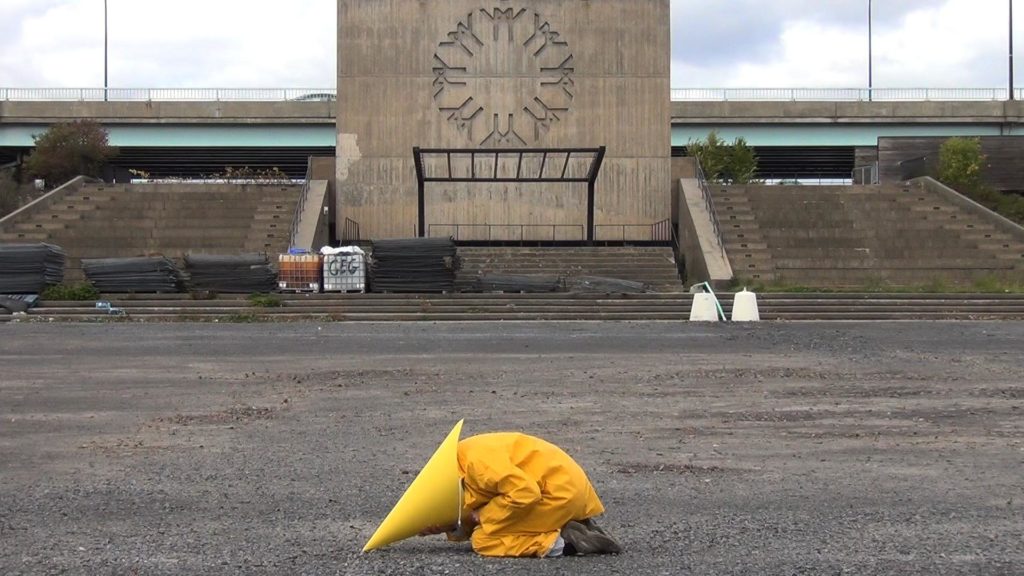One suspects it is not accidental that Montreal multidisciplinary artist Marlène Renaud-B. opened her new exhibition “Prendre le pouls” (Take the Pulse) on Halloween. This is a creepy show that rewards patient viewers with uncomfortable visions of alienation and dissociation. In Renaud-B.’s work, the ghosts are restless, but rattle their chains very softly; they’re patient but persistent. And bright yellow.
The set-up is simple enough: video camera in tow, Renaud-B. travelled to remote, institutional or utopian parts of Montreal, as well as to similar sites in the symbolically loaded territory of Marfa, Texas, and parts of New Mexico, dressed in canary-yellow hazmat suits. (There is no way this choice of dress could have been timed with the recent Ebola outbreak and its subsequent, malevolent iconography, but there is also no avoiding the moment of recognition.) The hazmat suits were paired with large, face-obscuring paper cones, worn over Renaud-B.’s head (sometimes white, sometimes a matching yellow).
What, in the video, appear to be large sticks of yellow chalk—but are actually large needles—are set inside the closed, narrow end of each cone. Renaud-B. then kneels on the ground and draws circles over and over, using her head to guide the needle—or, in the case of the Musée d’art contemporain de Montréal’s imposing front door, Renaud-B. scratches at one of the structures facing the entrance. (I later learned that whenever Renaud-B. dragged or drew the needle over a surface, the sound was amplified by the paper cone and recorded.)
At first, the videos appear to record silly stunts, actions that could be read as parodies of clownish performance art. But the devil is in the details.
The cone resembles a dunce cap, of course, but also a KKK hood, a wizard’s hat, and, eerily, the pillowcase-shaped hoods infamously placed over the heads of tortured prisoners at Abu Ghraib (in one video recorded outside a military installation in Marfa, Renaud-B. is interrupted and stopped by an unseen guard—perhaps he caught the reference?).
Furthermore, the hazmat yellow is not only accidentally topical—the yellow is sickly, not cheery, bilious in the dull sunlight, and when the wind catches the hazmat suit, Renaud-B.’s body appears to suddenly inflate and distort, like a bloating corpse. The gesture of kneeling also evokes Quebec’s historical Catholic culture: the ritualistic and metaphysical implications of prostrating oneself are obvious, as is the inherent deference to power embedded in that action.
Given these resonant tropes of power and its abuses, it would be easy to read this installation as a record of defeat, a performed act of resignation—except for that simple, pesky needle. In each action performed, Renaud-B.’s kneeling-but-unbowed determination to “make her mark” by scratching this item against the surface using only the top of her (often wind-blasted) head registers as both an act of simple inscription (akin to I-was-here graffiti) and a perhaps futile but still resolute act of defiance; defiance of the very elements—the wind and cold and clouds—and of the power structures that created the spaces she inhabits.
My only qualm with this otherwise intriguing show is Renaud-B.’s decision to include a large, motion-activated replica of her headgear, a sculpture that takes up half of the gallery. Perhaps it is meant to further “activate” the space (how I despise the current curatorial craze for “activation”), but in reality the sculpture is obstructive and distracts from the real action on the video screens. Why travel all the way to Texas, risking arrest, only to let these evocative performance documents be occluded by a giant stunt piece?









